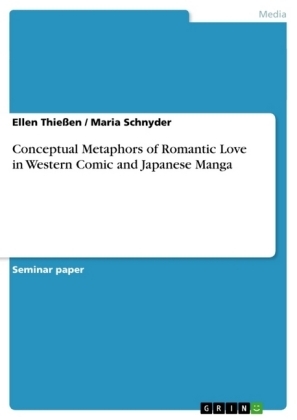
Conceptual Metaphors of Romantic Love in Western Comic and Japanese Manga
Seiten
2011
|
11002 A. 2. Auflage
GRIN Verlag
978-3-656-05172-5 (ISBN)
GRIN Verlag
978-3-656-05172-5 (ISBN)
- Titel nicht im Sortiment
- Artikel merken
Seminar paper from the year 2009 in the subject Communications - Broadcast and entertainment, grade: 1,0, University of Groningen (Faculty of Arts ), course: Language, Communication and Culture, language: English, abstract: According to Lakoff and Johnson (1980), metaphors involve a mapping of a tangible source domain on an intangible target domain and enable therefore the expression of concepts difficult to verbalise as such. ROMANTIC LOVE is one of these concepts. Indeed, "romantic love is commonly thought of as a mysterious emotion which it is notoriously difficult to pin down. [...] Various authors in various disciplines have expressed the view that this is a concept that is difficult to grapple with and define" (Kövecses, 1986). By analysing the conceptual metaphors used to describe ROMANTIC LOVE in conventionalised language, Kövesces succeeded to describe the constituents and structure of this concept.Kövecses research on the concept of ROMANTIC LOVE and the cultural variation of metaphor is based exclusively on verbal evidence. As Charles Forceville (2005:69) acknowledged, "in the interest of enriching insights into ideological conceptual metaphors, non-verbal and multimedial representations need to be investigated as well"; mostly in order to break "the vicious cycle of saying that verbal metaphoric expressions are evidence of conceptual metaphors, and then saying that we know that because we see conceptual metaphors expressed in language" (Cienki, 1998). The present paper aims to extend Kövecses research by analysing the visual expression of ROMANTIC LOVE and its cross-cultural variation in comics. Indeed, as Forceville (2005:71) mentioned, "comics are a good source of pictorial data for such a project: unlike, for instance, realistic photographs and live-action films, which are more or less 'naturally' mirror real-life manifestations of emotions, comics and cartoons make use of stereotypical exaggerations and of a rudimentary 'sign-system' very much like a language".In a first part, our paper will show how Kövecses' characterisation of the concept of ROMANTIC LOVE surfaces visually in the comic Asterix. The second part of this paper aims to explore this cross-cultural variation in the visual domain by comparing the results of the analysis of Asterix to Japanese Manga. Our research will be done on following data: three volumes of German translations of the French comic Asterix Asterix (Asterix als Legionär (Vol. 10), Asterix und Latraviata (Vol. 31), and Obelix auf Kreuzfahrt (Vol. 30)) and the Japanese manga I''s (Vol. 7), Tsubasa (Vol. 13), Natsuki Takaya (Vol. 3). In all of these comics, romantic love plays an essential role.
| Erscheint lt. Verlag | 17.11.2011 |
|---|---|
| Sprache | englisch |
| Maße | 210 x 297 mm |
| Gewicht | 100 g |
| Themenwelt | Sozialwissenschaften ► Kommunikation / Medien ► Allgemeines / Lexika |
| Sozialwissenschaften ► Kommunikation / Medien ► Medienwissenschaft | |
| Schlagworte | Asterix • conceptualmetaphors • Conceptual Metaphors • forceville • Kövecses • lakoff • Manga • metaphors • romantic love • Romanticlove |
| ISBN-10 | 3-656-05172-0 / 3656051720 |
| ISBN-13 | 978-3-656-05172-5 / 9783656051725 |
| Zustand | Neuware |
| Haben Sie eine Frage zum Produkt? |
Mehr entdecken
aus dem Bereich
aus dem Bereich
Falzen, Heften, Binden für Gestalter
Buch | Hardcover (2023)
Verlag Hermann Schmidt
CHF 76,95
Das offizielle Adressbuch der Stadt Tübingen
Buch (2023)
Ungeheuer + Ulmer (Verlag)
CHF 39,95
Das offizielle Adressbuch der Stadt Freiberg
Buch (2023)
Ungeheuer + Ulmer (Verlag)
CHF 20,85


